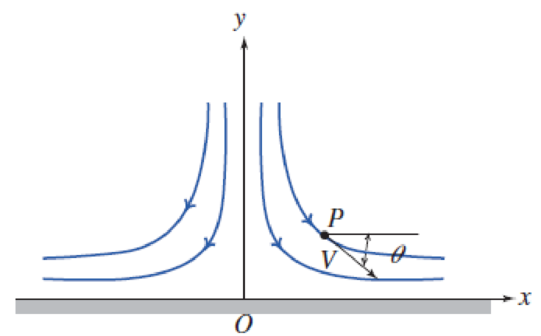
Concept explainers
When an incompressible, nonviscous fluid flows against a plate in a plane (two-dimensional) flow, an exact solution for the equations of motion for this flow is u = Ax, υ = −Ay, with A > 0 for the sketch shown. The coordinate origin is located at the stagnation point 0, where the flow divides and the local velocity is zero. Plot the streamlines in the flow.

P2.6
Want to see the full answer?
Check out a sample textbook solution
Chapter 2 Solutions
Fox and McDonald's Introduction to Fluid Mechanics
Additional Engineering Textbook Solutions
Starting Out with C++ from Control Structures to Objects (9th Edition)
Web Development and Design Foundations with HTML5 (8th Edition)
Degarmo's Materials And Processes In Manufacturing
Starting Out with Programming Logic and Design (5th Edition) (What's New in Computer Science)
Introduction To Programming Using Visual Basic (11th Edition)
Starting Out With Visual Basic (8th Edition)
- The figure below shows 4 streamlines corresponding to a free vortex flow. The streamlines are concentric eircles, and the velocity magnitude Valong each streamline is given by V = K/r, where r is the radial distance from the center, and K is a constant. Assume the flow to be steady, incompressible and inviscid. Neglect the effects of gravity. If K = 20 m2/s and the fluid density is 1000 kg/m, what is the magnitude of the static pressure difference AP between 2 streamlines at radial distances r = 3 m and r = 4 m? Ap = 1 КРа. C r Вarrow_forwarda) A Newtonian fluid flows with external force in the y-direction in space between two stationary parallel plates that are separated by a distance 2D as shown in Figure 1. The length and the width of each plate are L and W, respectively. 2D Center Line Figure 1 Flow between parallel plates Derive the velocity profile for system using shell momentum balance. State all your postulate and assumptions.arrow_forwardQ.2 A flow is described by the stream function v = 25xv, The coordinates of the point at which velocity vector has a magnitude of 4 units and makes an angle 150 ° with the X-axis is A x=1.0, y=0.5774 B X=0.5774, Y=1.0 WRONG C X=1, Y=-0.5774 D X=-1, Y=0.5774arrow_forward
- 3.4 Consider a steady, incompressible, 2D velocity field for motion parallel to the X-axis with constant shear. The shear rate is du/dy Ay. Obtain an expression for the velocity field V. Calculate the rate of rotation. Evaluate the stream function %3D for this flow field. Ay Ay + В і, о, Ay + By+ C 6. Ans: V= 2arrow_forward1. For incompressible flows, their velocity field 2. In the case of axisymmetric 2D incompressible flows, where is Stokes' stream function, and u = VXS, S(r, z, t) = Uz = where {r, y, z} are the cylindrical coordinates in which the flow is independent on the coordinate and hence 1 Ꭷ r dr 1 dy r dz Show that in spherical coordinates {R, 0, 0} with the same z axis, this result reads Y(R, 0, t) R sin 0 S(R, 0, t) UR uo Y(r, z, t) r = = -eq, and Up = = 1 ay R2 sin Ꮎ ᎧᎾ 1 ƏY R sin Ꮎ ᎧR -eq 2 (1) (2) (3)arrow_forwardFlow through a converging nozzle can be approximated by a one-dimensional velocity distribution u=vo (1+2). For the nozzle shown below, assume that the velocity varies linearly from u = vo at the entrance to u = 3v, at the exit. Compute the acceleration at the entrance and exit if vo=10m/s and L = 1m. x=0 X u= :326 x=Larrow_forward
- Q.5 The velocity components in x and y direction 2 are given by u = Axy° - xy; v = > ху; v — ху = xy² – 3/4 .4 y*. The value of A for a possible flow field involving an incompressible fluid is: A -3/4 В 3 C 4/3 D -4/3arrow_forwardCourse: Fluid Mechanicsarrow_forwardPlease don't provide handwritten solution.arrow_forward
- 3.14. Find the vorticity in polar coordinates for the following velocity com- ponents (a) v=rsin 0, ve = 2r cos 0 (b) v = cos 0, 11=0arrow_forward3. The velocity components of a two-dimensional incompressible fluid flow are prescribed as v=-3x²² u=-1 i) Determine the stream function. ii) Using excel plot the stream function for y=-5 and y=-20 from x = 0 to x = 5.arrow_forwardSolve correctly please.arrow_forward
 Elements Of ElectromagneticsMechanical EngineeringISBN:9780190698614Author:Sadiku, Matthew N. O.Publisher:Oxford University Press
Elements Of ElectromagneticsMechanical EngineeringISBN:9780190698614Author:Sadiku, Matthew N. O.Publisher:Oxford University Press Mechanics of Materials (10th Edition)Mechanical EngineeringISBN:9780134319650Author:Russell C. HibbelerPublisher:PEARSON
Mechanics of Materials (10th Edition)Mechanical EngineeringISBN:9780134319650Author:Russell C. HibbelerPublisher:PEARSON Thermodynamics: An Engineering ApproachMechanical EngineeringISBN:9781259822674Author:Yunus A. Cengel Dr., Michael A. BolesPublisher:McGraw-Hill Education
Thermodynamics: An Engineering ApproachMechanical EngineeringISBN:9781259822674Author:Yunus A. Cengel Dr., Michael A. BolesPublisher:McGraw-Hill Education Control Systems EngineeringMechanical EngineeringISBN:9781118170519Author:Norman S. NisePublisher:WILEY
Control Systems EngineeringMechanical EngineeringISBN:9781118170519Author:Norman S. NisePublisher:WILEY Mechanics of Materials (MindTap Course List)Mechanical EngineeringISBN:9781337093347Author:Barry J. Goodno, James M. GerePublisher:Cengage Learning
Mechanics of Materials (MindTap Course List)Mechanical EngineeringISBN:9781337093347Author:Barry J. Goodno, James M. GerePublisher:Cengage Learning Engineering Mechanics: StaticsMechanical EngineeringISBN:9781118807330Author:James L. Meriam, L. G. Kraige, J. N. BoltonPublisher:WILEY
Engineering Mechanics: StaticsMechanical EngineeringISBN:9781118807330Author:James L. Meriam, L. G. Kraige, J. N. BoltonPublisher:WILEY





